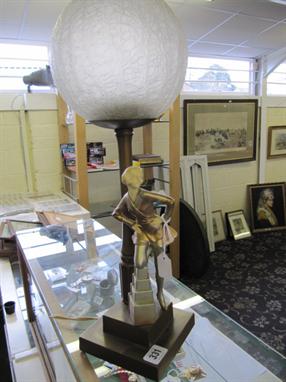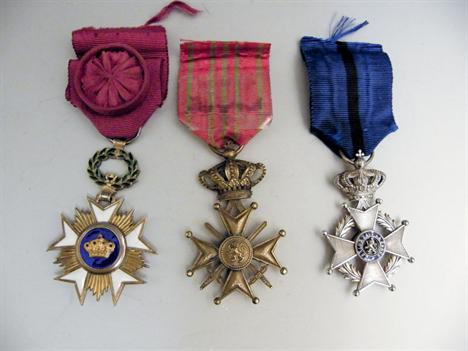We found 131341 price guide item(s) matching your search
There are 131341 lots that match your search criteria. Subscribe now to get instant access to the full price guide service.
Click here to subscribe- List
- Grid
-
131341 item(s)/page
A Post War Italian Sommerso glass bottle by Luciano Gaspari for Salviati of shouldered sleeve form with narrow collar neck having a blue interior above a blue and white opaque twist to the foot, height 33 cm, together with a similar period cased body bowl by A.V.E.M with green rings to a graduated pink tinted ground, width 17.5 ccm (2).
ARSENAL Home programme v Racing Club De Paris, 30/11/1932, first of what was to become a regular fixture between the two teams both pre-war and post-war. Apparently Arsenal beat the French National team 26-1 in December 1904, so the French were looking for revenge !!!. This issue has a slight fold, rusty staples have been removed, but this apart the programme is in good condition. Generally good
1960 INTERCONTINENTAL CUP FINAL Real Madrid v Penarol, extremely rare official Real Madrid Revista dated Sept 1960, post match celebration edition released days after the 2nd leg of the first ever Intercontinental Cup. Front page entitled "Numero Extraordinario Dedicato A La Primera Copa Intercontinental De Clubs Campeones". Very hard to find issue. Good
MAN UTD Two programmes, away at Villa 10/1/48, FA Cup which United won 6-4 on their way to winning the trophy. The other is the famous home programme v Sheffield Wednesday 19/2/58, Cup, the first post Munich match, although line-ups are blank and token is intact, the back cover is missing and this issue is probably useful for framing the team line-ups or for the front cover. The Villa issue is a little worn and has minor repairs but no writing. As described
WOLVES Folder containing 135 match reports of Wolves games from 1899-1953, 26 reports are pre First World War, 106 between the Wars and 3 Post-war. Seasons well represented are 1912/13, 1923/24, 1926/27, 1932/33, 34/35 abd 36/37. All are original newspaper cuttings, neatly laid out, many with line-ups etc and some photographs. Cuttings are from the Birmingham Gazette. Good
AFTER SAMUEL FREDERICK BROCAS "The Bank of Ireland", "View of the Corn Exchange-Burgh Quay & Custom House, Dublin", "Lying-In Hospital, Dublin", "A View of Carlisle Buildings from Carlisle Bridge, Dublin", "Great Court-Yard, Dublin Castle" and "View of the Post Office and Nelson`s Pillar, Sackville St, Dublin", a set of six coloured engravings, published by McCleary, 32/39 Nassau Street, Dublin, 25 x 39 cm (ILLUSTRATED)
WWII – the Holocaust – Auschwitz rare SS field post card with typed message from an SS Oberscharfuhrer from Auschwitz written from Siemianowitz Poland sending his greetings and saying [trans.] ‘I only have another week in this dump then back to Auschwitz you can send me any reply direct to the camp via the SS Lagerkommandantur...’
A pair of cultured pearl and diamond cluster stud earrings, each centred with a cultured pearl within a diamond border, unmarked , 6.4 grams gross. Fair condition. There is dirt/makeup/staining to one of the culured pearls that would need attention, the outer diamonds are a little dull due to inclusions. There are scratches and areas of discolouration to the setting, post and back fittings.
217167 WWI Letters. An archive of approx. 280 letters home from Richard Gale of the 164th Machine Gun Company of the 55th West Lancashire Division, and, subsequently, the 126th Machine Gun Company of the 42nd East Lancashire Division, 8th September 1916 to 13th November 1918, a remarkable, complete archive, a mixture of pen and pencil, the letters mostly four pages or less but including longer letters on ruled, graph and plain paper of various sizes, addressed to his parents and usually signed `Dick`, majority with orig. envelopes with Field Post Office and censor stamps, arranged chronologically with a few related sundry items in poly sleeves in seven modern ring binders, the envelopes or letters mostly numbered from 1 to 361 (letters 136-207 while sick and on leave in the United Kingdom not present-see notes field below), the first item being an unnumbered typed copy of a confidential memorandum recommending Richard Gale for the Military Cross, `For devotion to duty and conspicuous gallantry in action on the 26/3/18 [and] on the 27/3/18... Under heavy shellfire, Lieut. Gale went out and unhitched the killed and wounded horses, so enabling the chief transport to move away to cover`, the first letter beginning innocuously with a description of the Channel crossing but immediately Gale finds himself on the Somme the sector of the Western Front, Just a great line in haste in the trenches. I`m still alive & kicking. I am quite happy out here tho` I think I can flatter myself on having seen quite a little bit of Hell. Conjure up in your mind the filthiest & most diabolical sight imaginable & you`ll be somewhere near the mark... don`t worry as I`m as fit as a fiddle, only after a time dead bodies etc. begin to smell!! & it`s beastly bumping into them at night` (letter 15, c. 30th September 1916), `I am still happy tho` I`ve seen Hell - I mean this. Real true unadulterated horror. But one can make it what one likes. I keep smiling. By your letter I see you misunderstood my appointment. I am in command of a section & not second in command of a section. The day before yesterday I was personally congratulated by the General for good work in the front line so I am feeling rather lucked about it all. These were the circumstances. On coming into the front line I found I had only three guns (the rest being either knocked out or lost) to hold a front of very nearly a mile. However there were two battalions their each having some lewis guns. So I went up to the battalion commanders (Colonels) & gently informed them that I was going to take over all their Lewis guns under my command, to which they readily agreed...`, (letter 17, 30th September 1916), `Your joke re the German emperor`s new order re socks....
WILLIAM DE MORGAN, TWO CERAMIC TILES, CIRCA 1890, one painted with five flower stems, in aubergine and green on a white ground impressed mark, minor rim chips, impressed Merton Abbey marks, 15.5cm square; the other with panels of flowers in aubergine and blue, impressed post 1882 mark `W de Morgan`, 15cm square (2)
MICHAEL CASSON, LARGE STONEWARE JUG, LATE 20TH CENTURY, saltglazed, impressed seal mark, 39cm high, Literature: Cooper, Emmanuel, Obituary, Independant newspaper, 17th December 2003. Note: Michael Casson (1925-2003) was one of the pioneers in the renaissance of studio pottery in the post-war period, a greatly respected and a charismatic teacher and educator who influenced several generations of potters. After reading Bernard Leach`s 1940 `A Potter`s Book`, Casson responded positively to its concept of unity and wholeness, and its advocacy of functional and individual wares. Together with his wife, Sheila, he sought to put Leach`s ideas into practice.
HARALD NEILSEN FOR GEORG JENSEN, SILVER JEWELLERY SUITE, LATE 1950S, comprising a necklace and matching bracelet, each composed of stylised foliate motifs, interspersed by pairs of spherical silver beads, with slightly domed circular clasp and safety clip, post 1945 maker`s mark, also stamped STERLING DENMARK and numbered 96, with import marks for London 1958 and 1959, 38.9g and 22.6g, Lengths: 42cm and 19cm
SIR ROBERT MATTHEW, ARMCHAIR, 1960S, with loose squab cushion, Note: Robert Matthew was the son of John Matthew (also an architect, and the partner of Sir Robert Lorimer). He was born and brought up in Edinburgh, and attended the Edinburgh College of Art. In 1946, Matthew moved to London, becoming Chief Architect and Planning Officer to the London County Council, where he served from 1946 to 1953, working on the post-war reconstruction of Greater London and masterminding the Festival of Britain including such buildings as the Royal Festival Hall, 1951. In 1956, with Stirrat Johnson Marshall, Robert Matthew established the firm of RMJM (Robert Matthew, Johnson Marshall) in Edinburgh and London. Their first project was New Zealand House in the Haymarket, London. In 1953 he returned to Edinburgh to become the first Professor of Architecture at the University of Edinburgh, where he established the new Department of Architecture in collaboration with RMJM, in a manner that has been compared to that of Walter Gropius at the Bauhaus. He continued as Professor there until 1968. The Matthew Architecture Gallery is now housed in the Department in his honour. In Edinburgh Matthew was closely involved with Basil Spence and Alan Reiach in the University`s development plan for George Square, and also involved with the Royal Commonwealth Pool, British Home Stores on Princes Street, Edinburgh Airport, Lothian Regional Council Building and Wester Hailes Education Centre.
-
131341 item(s)/page











































